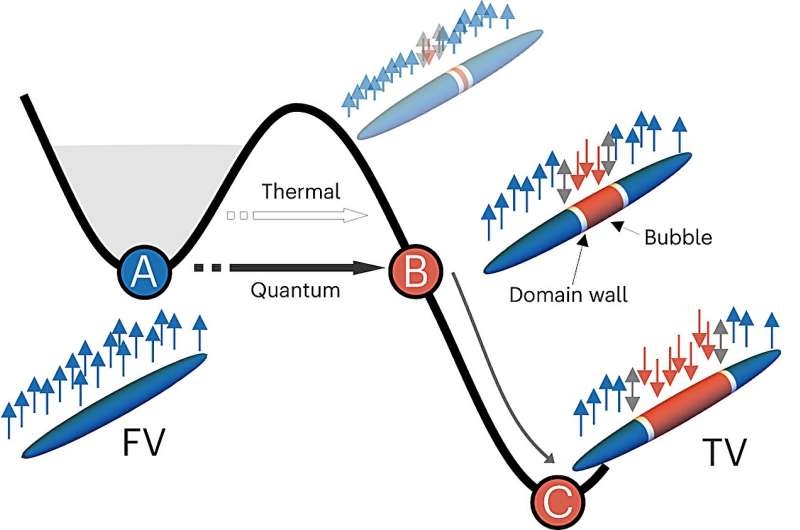This article has been reviewed according to Science X's editorial process and policies. Editors have highlighted the following attributes while ensuring the content's credibility:
fact-checked
peer-reviewed publication
trusted source
proofread
New research sheds light on a phenomenon known as 'false vacuum decay'

An experiment conducted in Italy, with theory support from Newcastle University, has produced the first experimental evidence of vacuum decay.
In quantum field theory, when a not-so-stable state transforms into the true stable state, it's called "false vacuum decay." This happens through the creation of small localized bubbles. While existing theoretical work can predict how often this bubble formation occurs, there hasn't been much experimental evidence.
The ultracold atoms lab of the Pitaevskii Center for Bose-Einstein Condensation in Trento reports for the first time the observation of phenomena related to the stability of our universe. The results arise from the collaboration among the University of Newcastle, the National Institute of Optics of CNR, the Physics Department of the University of Trento and Tifpa-Infn, and it has been published in Nature Physics.
The results are supported by both theoretical simulations and numerical models, confirming the quantum field origin of the decay and its thermal activation, opening the way to the emulation of out-of-equilibrium quantum field phenomena in atomic systems.
The experiment uses a supercooled gas at a temperature of less than a microKelvin from absolute zero. At this temperature, bubbles are seen to emerge as the vacuum decays and the Newcastle University's Professor Ian Moss and Dr. Tom Billam were able to show conclusively that these bubbles are a result of thermally activated vacuum decay.
Ian Moss, Professor of Theoretical Cosmology at Newcastle University's School of Mathematics, Statistics and Physics, said, "Vacuum decay is thought to play a central role in the creation of space, time and matter in the Big Bang, but until now there has been no experimental test. In particle physics, vacuum decay of the Higgs boson would alter the laws of physics, producing what has been described as the 'ultimate ecological catastrophe.'"
Dr. Tom Billam, Senior Lecturer in Applied Math/Quantum, added, "Using the power of ultracold atom experiments to simulate analogs of quantum physics in other systems—in this case the early universe itself—is a very exciting area of research at the moment."
The research opens up new avenues in the understanding of the early universe, as well as ferromagnetic quantum phase transitions.
This groundbreaking experiment is only the first step in exploring vacuum decay. The ultimate goal to is find vacuum decay at the temperature of absolute zero where the process is driven purely by quantum vacuum fluctuations. An experiment in Cambridge, supported by Newcastle as part of a national collaboration QSimFP, aims to do just this.
More information: A. Zenesini et al, False vacuum decay via bubble formation in ferromagnetic superfluids, Nature Physics (2024). DOI: 10.1038/s41567-023-02345-4
Journal information: Nature Physics
Provided by Newcastle University



















